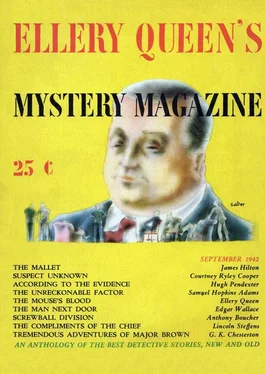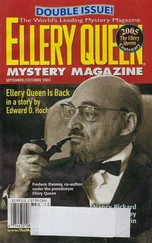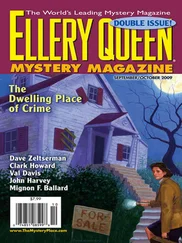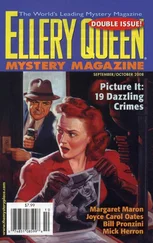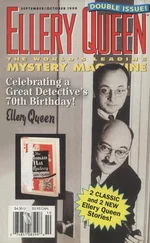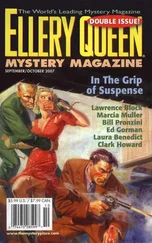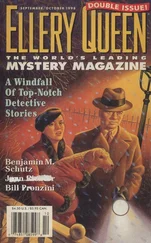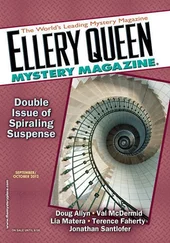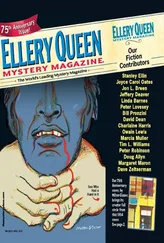Энтони Бучер - Ellery Queen’s Mystery Magazine. Vol. 3, No. 4, September 1942
Здесь есть возможность читать онлайн «Энтони Бучер - Ellery Queen’s Mystery Magazine. Vol. 3, No. 4, September 1942» весь текст электронной книги совершенно бесплатно (целиком полную версию без сокращений). В некоторых случаях можно слушать аудио, скачать через торрент в формате fb2 и присутствует краткое содержание. Город: New York, Год выпуска: 1942, Издательство: The American Mercury, Жанр: Детектив, на английском языке. Описание произведения, (предисловие) а так же отзывы посетителей доступны на портале библиотеки ЛибКат.
- Название:Ellery Queen’s Mystery Magazine. Vol. 3, No. 4, September 1942
- Автор:
- Издательство:The American Mercury
- Жанр:
- Год:1942
- Город:New York
- ISBN:нет данных
- Рейтинг книги:4 / 5. Голосов: 1
-
Избранное:Добавить в избранное
- Отзывы:
-
Ваша оценка:
- 80
- 1
- 2
- 3
- 4
- 5
Ellery Queen’s Mystery Magazine. Vol. 3, No. 4, September 1942: краткое содержание, описание и аннотация
Предлагаем к чтению аннотацию, описание, краткое содержание или предисловие (зависит от того, что написал сам автор книги «Ellery Queen’s Mystery Magazine. Vol. 3, No. 4, September 1942»). Если вы не нашли необходимую информацию о книге — напишите в комментариях, мы постараемся отыскать её.
Ellery Queen’s Mystery Magazine. Vol. 3, No. 4, September 1942 — читать онлайн бесплатно полную книгу (весь текст) целиком
Ниже представлен текст книги, разбитый по страницам. Система сохранения места последней прочитанной страницы, позволяет с удобством читать онлайн бесплатно книгу «Ellery Queen’s Mystery Magazine. Vol. 3, No. 4, September 1942», без необходимости каждый раз заново искать на чём Вы остановились. Поставьте закладку, и сможете в любой момент перейти на страницу, на которой закончили чтение.
Интервал:
Закладка:
Manton Kent glanced at his fingers.
“I’ve always heard they’d be dirty from lampblack.”
“No. This is a special pad, and sensitized paper. It leaves no marks on the hands. Now, if you’ll just fill out this card: your name, address, whom to notify in case of accident.”
Manton Kent sat at a desk.
“It gives you a feeling of security, doesn’t it?” he queried. Then as he wrote:
“I’ve been wondering why you haven’t been able to learn something by fingerprints about that murder case.”
“You mean the Tilliver affair. Evidently the murderer wore gloves.”
“Oh, of course.”
Manton Kent finished the writing of his description and handed the completed card to the inspector. An agent happened to be passing. Jessup called him:
“File this for Mr. Kent, please. Civil fingerprints.”
The agent took the card and hurried away. Inspector Jessup turned to a dissertation on the fingerprint division. At last:
“Suppose now we step into the Technical Division — the Crime Laboratory, as it is known.” From a near-by corridor of filing cases, a machine began to whir. It caught the inspector’s attention. “Before we leave the fingerprint section,” he said hastily, “I want to show you how law enforcement has borrowed ideas from the business world.”
“Yes?”
“By using an ordinary mechanical card sorter to catch crooks.” He led the way to the machine, where a special agent and a fingerprint clerk were busily feeding it large stacks of cards, each punctured with many holes.
“An indexing machine,” said Manton Kent. “We have a dozen of them in my organization.”
“Of course. We merely adapted it to crooks. Instead of names or addresses, the prongs of that machine are set to fit into the holes in a card which designate one certain man’s fingerprint classification. That big pile of cards the men are feeding it represents a search for a certain criminal. They are the records of every crook who has a classification resembling that of the wanted man in any manner whatever. And if the crook we want is among them, this machine will find him.” Manton Kent looked toward the side of the sorter, where two large slots appeared. One was rapidly filling with cards, representing rejections. The other was empty. The inspector said:
“Let’s stay and see if they find the fellow.”
“Certainly.”
A minute passed. The machine stopped, its piles of cards exhausted. The inspector turned away without waiting for the eye signal of the special agent to tell him that a search of the entire Identification Unit in the hope of finding some criminal reference to Manton Kent had been in vain.
“I suppose that machine is infallible,” said Kent.
“If a record exists in the bureau,” the inspector answered. “Unfortunately, some of our enforcement bodies and prisons did not keep complete files prior to ten years ago. So, in old cases, we are always at a disadvantage.”
“Unfortunate,” answered Mr. Kent.
“Very. Shall we take a look at the Crime Laboratory?”
He led the way to another double door, and held it wide for his guest. They entered an anteroom, filled with exhibits of guns, an X-ray machine for looking into packages without unwrapping them, pictured histories of scientific crime detection in widely known cases.
“You’ve seen all this on the tours you’ve taken,” said the inspector. “Let’s go behind the scenes.”
“Wonderful.”
The inspector did not answer. He led the way into a big room that reeked with chemicals and stepped swiftly to a laboratory table where a sober-faced man in a white smock had apparently just completed a microscopic examination of a sheer silk stocking. Near by, on the table, lay a woman’s suède shoe.
“What experiment is this?” the inspector queried.
“The shoe is part of the Tilliver evidence,” answered the scientist. “The stocking came from the room of Mrs. Bradford Bowen, in the May town Hotel.”
Kent stepped closer.
“Oh, a suspect?”
The inspector smiled.
“Be patient now. I’ll show you how scientific detection works out. This, as you have guessed, is the woman’s shoe that was found outside the Tilliver house after the murder. The next morning, Mrs. Bowen reported to the hotel management that a shoe and a pair of gloves had been stolen from her room — that someone must have taken them while she was out.”
“Easy enough,” said Mr. Kent.
“Yes, of course. But we can’t accept the palpable. So we conducted experiments to prove or dispose her story. You will notice that this stocking, which we obtained from her for experimental purposes, is of an extremely odd shade. We have determined that she never wears any other type. Therefore, microscopic examinations were made, both of the shoe and the stocking. The shoe revealed many tiny shreds of silk that match the fibers of this hose exactly. But the scientist could find no other fibers.” He faced the besmocked laboratory man. “Is that correct, Mr. Moberton?”
“That is correct, sir, indicating that the shoe has not recently been on any other foot than that of this particular woman.”
Manton Kent exhibited interest:
“Then you do have a suspect?”
“It begins to look that way. This experiment points suspicion either toward Mrs. Bowen or some person who may have stolen that shoe from her room, in an attempt to divert suspicion toward her.”
“That makes it a woman’s deal all the way round, doesn’t it?” asked Kent. “I see your deduction now. Two women are possibly in love with this Tilliver. One decides to kill him. So she steals a shoe and pair of gloves from her rival and leaves them at the scene of the crime.”
Jessup laughed, and slapped his man on the shoulder.
“The first thing you know, we’ll be giving you an examination for the job of special agent. That’s a very good deduction, except for the motive, which appears to have been blackmail — on Tilliver’s part, not on that of the murderer.”
Kent’s eyes had widened.
“Oh, you’ve established that?”
“Is the evidence handy, Mr. Moberton?” asked the inspector; then, following the scientist’s glance, he moved toward a few pieces of charred paper under a glass cover. “This was found in the fireplace.”
“But I don’t see anything on it — merely some black ashes.”
“Photography, under the ultraviolet ray, brought out the writing. Evidently Tilliver was in tight circumstances, and knew somebody who was rich. Have you the photostatic copy of your experiment on this charred document, Mr. Moberton?”
Silently the scientist opened a drawer and brought out the photograph, while Kent stared as with disbelief.
“It seems impossible!”
“Oh, we do lots of impossible things,” Jessup said.
“You say that this letter was sent from Tilliver to someone else?”
“Yes. It has been determined to be Tilliver’s writing.” He referred to the photograph. “You will notice that this fragment of the letter says: ‘I need a hundred thousand dollars and you have got it to give me. And unless you do give it to me, Old Pal, the reputation you have built up over all these years will not be worth five cents.’ ”
Manton Kent cleared his throat. “Is that all the writing you were able to recover?”
“Unfortunately, that is all. Except for the beginning of the letter.”
“You mean the name of the person to whom it was sent?”
“It was only ‘Dear Pal.’ ”
“Unfortunate,” exclaimed Manton Kent, and gave his attention to the woman’s shoe. The inspector eyed him closely; Kent’s demeanor was that of enthusiastic interest, and nothing more. Jessup turned.
“Suppose we see what experiments are being made with the gloves,” he suggested, and led the way with a pawlike hand on the suspect’s shoulders. Again he sought to break through possible armor. “Perhaps I shouldn’t dismiss that letter so lightly, because it really did aid us to some extent. It showed us the motive was a quarrel over blackmail. Tilliver had sent it to an old friend, apparently. That person evidently became wild with anger, rushed to Tilliver’s house, stealing the shoe and gloves on the way. There was a fight, or quarrel, at least a struggle—”
Читать дальшеИнтервал:
Закладка:
Похожие книги на «Ellery Queen’s Mystery Magazine. Vol. 3, No. 4, September 1942»
Представляем Вашему вниманию похожие книги на «Ellery Queen’s Mystery Magazine. Vol. 3, No. 4, September 1942» списком для выбора. Мы отобрали схожую по названию и смыслу литературу в надежде предоставить читателям больше вариантов отыскать новые, интересные, ещё непрочитанные произведения.
Обсуждение, отзывы о книге «Ellery Queen’s Mystery Magazine. Vol. 3, No. 4, September 1942» и просто собственные мнения читателей. Оставьте ваши комментарии, напишите, что Вы думаете о произведении, его смысле или главных героях. Укажите что конкретно понравилось, а что нет, и почему Вы так считаете.
